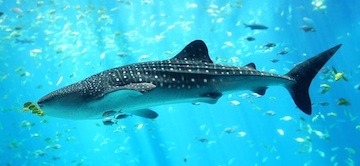390516-warm giant.jpg

Whale shark. Credit: National Oceanic and Atmospheric Administration
The whale shark spends some of its day cruising through the warm water near the ocean surface. When it’s time to eat, though, it sometimes heads for the fridge — depths of a quarter of a mile or greater, where the water is much colder. That isn’t much of a problem because the shark is a gigantotherm — an organism that relies on its great size and a special anatomy to keep it warm.
The whale shark is the biggest fish in the oceans. It can reach almost 60 feet in length, and weigh up to 35 tons. It maintains its massive body by filtering tiny organisms from the water. During the day, these organisms drop hundreds of feet below the surface — so the whale shark follows.
The problem is that the deeper water can be 30 or 40 degrees colder than near the surface. Spending time in the colder water cools the shark’s body and blood — especially because it feeds by passing water across its gills, which have a lot of surface area and contain a lot of blood. But recent research shows how it may keep from catching a chill.
One way is its anatomy. The shark’s internal organs are in its core, surrounded by tough muscle tissue that has few blood vessels. The muscle acts like a blanket, trapping the heat around the shark’s major organs and its central nervous system.
And because of the shark’s great size, there’s a lot of heat, which warms the blood after it passes through the gills. So although the whale shark spends much of the time in warm water, it’s perfectly comfortable diving into the chilly depths.
This episode of Science and the SeaTM was made possible by Chuck Nash Auto Group of San Marcos, Texas.

